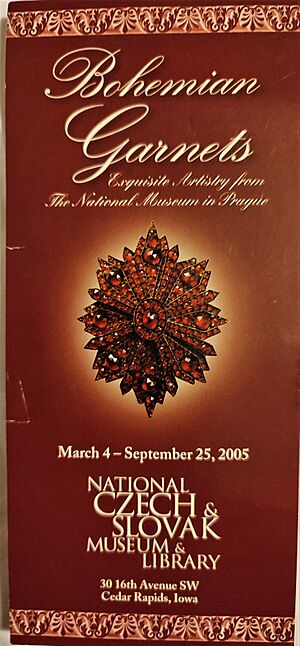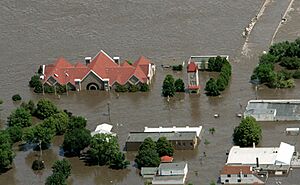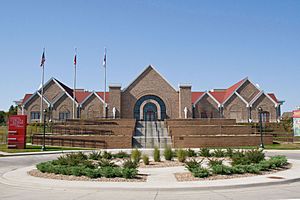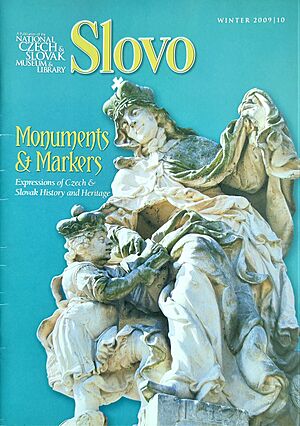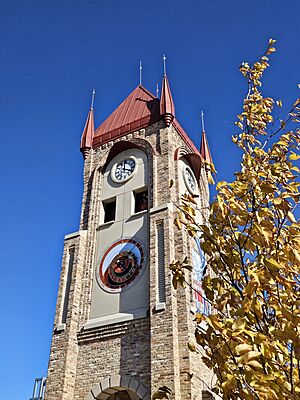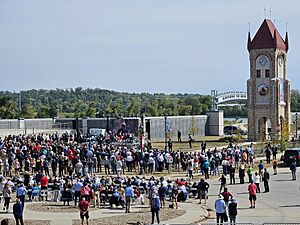- This page was last modified on 17 October 2025, at 10:18. Suggest an edit.
National Czech & Slovak Museum & Library facts for kids
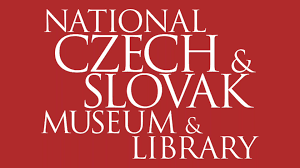 |
|
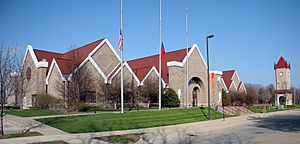 |
|
| Established | 1974 |
|---|---|
| Location | 1400 Inspiration Place SW Cedar Rapids, Iowa |
The National Czech & Slovak Museum & Library (NCSML) is a special place in Cedar Rapids, Iowa, USA. It's a museum and library that teaches about the history and culture of Czech and Slovak people. It started in 1974 and moved to its current spot in 1983.
A big flood in Iowa flood of 2008 badly damaged it. But the museum was rebuilt and made bigger, reopening in 2012. In 2018, the NCSML became a Smithsonian Affiliate. This means it joined a group of museums and schools that share resources with the famous Smithsonian. Dr. Cecilia Rokusek has been the President and CEO since 2018.
Contents
How the Museum Started and Grew
Early Days: 1974 to 1995
In 1974, some Czech Americans in Cedar Rapids wanted to save their Czech heritage. They started the Czech Fine Arts Foundation. By 1978, they had so many old items and papers that they opened a small Czech Museum in a three-room house. More items and helpers joined them.
In 1981, the collections moved to a new building. The goal was to show them to the public all the time. In 1983, they got an old immigrant home from the 1800s. They moved it to the museum's land and fixed it up to look like it did in the 1880s and 1890s.
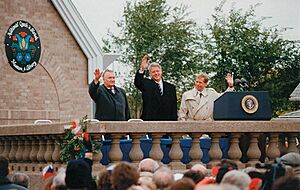
The presidents of the Czech Republic, Slovakia, and the United States dedicate the National Czech & Slovak Museum & Library in 1995.
The museum started to hire staff in 1983. During the 1980s, it got more old items and money from Czech and Slovak Americans. The museum also got its current name during this time. By the 1990s, the museum and library needed more space. They planned a new, much larger building.
Work on the new building began on October 28, 1993. On October 21, 1995, the new building was officially opened. Important leaders like U.S. President Bill Clinton, Czech President Václav Havel, and Slovak President Michal Kováč were there. About 7,000 people came to this special event.
Special Exhibits and Changes
Big Shows and Updates
On May 24, 1997, the NCSML opened a huge international exhibit. It was called "A Thousand Years of Czech Culture: Riches from the National Museum in Prague." This show featured amazing items borrowed from the National Museum in Prague. The museum said over 30,000 visitors from the U.S. and 22 other countries came to see it.
In 1998, a permanent exhibit called "Homelands: The Story of the Czech and Slovak People" opened. In 1999, the museum held its first history and culture conference.
In 2000, the museum made big changes. It added safe, climate-controlled storage rooms. It also created a new space for temporary exhibits. In the same year, the library's collection doubled. This happened when it got the Slavic language collection from Benedictine University.
The museum and library also started publishing Slovo in 2000. This is a journal about history and culture that comes out twice a year.
The museum kept growing its collections and events. In 2001, it planned to get more land for a research and performing arts center. It also started raising money to have $5 million by 2005. The NCSML said it had over 1,900 members in 2002.
In 2002, the museum opened "Kroje—Dress for the Dance of Life!" This exhibit showed traditional Kroje clothing until January 19, 2003. The museum also hosted meetings for groups interested in Czech glass and Czech-Slovak family history.
On March 4, 2005, the museum opened "The Bohemian Garnets" exhibit. This show featured jewelry, dishes, and other items with the Czech national stone, the garnet. These items were also borrowed from the National Museum in Prague.
The 2008 Flood and Rebuilding
How the Flood Affected the Museum
In 2008, the Cedar River flooded its banks. The museum and library were covered with 8 feet of water. This caused a lot of damage, estimated at $8 million or $9 million. The flood happened just days before the museum was going to announce plans to triple its size.
Museum staff managed to save two truckloads of items before the flood hit. They focused on saving Fine art and folklore items first. Two exhibits were destroyed, including one about the Prague Spring in 1968.
Right after the flood, items from the upper levels of the building (which the water didn't reach) were moved out. Damaged items were sent away to be fixed. Some library books went to Chicago to be freeze-dried and saved. The Chicago Conservation Center helped by giving expert advice on how to save textiles and linens.
Before the 2008 flood, about 35,000 people visited the museum each year. The library had about 30,000 Slovak-related items. Two-thirds of these were stored off-site and were not damaged. About 40 percent of the museum's items are Slovak. The museum has the largest collection of kroje outside Slovakia and the Czech Republic. Some of the oldest pieces are from the 1500s.
The flood damaged all 5,000 of the NCSML's phonograph records. These records showed 80 years of Czech and Slovak music. Luckily, the University of Iowa Libraries Preservation Department was able to fix most of them.
Moving and Expanding the Museum
After the flood, a temporary museum opened at Lindale Mall. In April 2010, the museum's temporary home moved to the Kosek Building in Cedar Rapids. This temporary space had a gallery and a museum gift shop. An exhibit called "Rising Above: The Story of the People and the Flood" also opened there. This exhibit focused on the 2008 flood and compared it to earlier floods in 1929 and 1993. It included stories from people who experienced the flood. The Kosek Building is still part of the Museum and Library today.
The Iowa General Assembly gave $10 million to help the museum rebuild. In October 2008, the Czech ambassador gave a $405,000 donation from the Czech Republic to help with the rebuilding.
After the flood, it was hard for the museum to get insurance. Other museums were also afraid to lend items because of the risk of another flood. The museum decided to move and expand the building to higher ground. Moving the 15-year-old building cost $713,000. This was much less than the $2 million it would cost to tear it down and rebuild it. Even after the flood damage, the building was still strong. The museum also wanted to save the original building because of its history and to avoid creating unnecessary landfill waste.
The museum building was moved 480 feet from its original spot. It was placed on a raised foundation. A special ceremony for the move happened on December 15, 2010. On June 8–9, 2011, the Museum and Library building, which weighed about 1,500 tons, was moved to its new site. The new site is 11 feet higher than the old one and 3 feet above the 2008 flood level. The museum called this event "A Monumental Move." They even set up a webcam so people could watch. The City of Cedar Rapids closed a street and a bridge so local people could watch too. The company that moved the museum said it was likely the largest museum ever moved to protect it from floods.
Besides moving the first building, the rebuilt museum is much bigger. It is now 50,000 square feet. This includes larger permanent and temporary exhibit areas, a bigger research library, and spaces for educational programs. It also has a new museum store, storage for collections, and work areas. The new building is designed to be energy-efficient. It has a new 5,500 square foot library and archives, a 51-seat theater, three galleries, and space for public and educational programs for up to 400 people. There is also underground parking for 65 cars, a terrace with a view of the Cedar River, and an outdoor amphitheater. The total cost to rebuild and recover was about $25 million.
The NCSML was recognized by the American Alliance of Museums in November 2008. In 2010, the museum started a campaign to raise $25 million. This money was for making the Kosek Building a permanent part of the NCSML. It also helped fix up The Immigrant Home and the Babi Buresh Center historic homes for tours. Money was also used to design and install a new permanent exhibit, cover costs from the flood cleanup, and grow the museum's savings to pay for daily costs. The NCSML expected about 54,000 visitors each year after reopening. This would bring over $1.1 million to the Cedar Rapids area.
Buresh Immigration Tower and Astronomical Clock
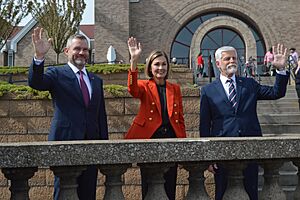
Slovak President Peter Pellegrini, Iowa Governor Kim Reynolds and Czech President Petr Pavel during the dedication ceremony on September 27, 2024
Almost 30 years after Presidents Bill Clinton, Václav Havel, and Michal Kovac visited the museum in 1995, new leaders came. On September 27, 2024, Czech President Petr Pavel and Slovak President Peter Pellegrini visited. They were there to dedicate the only Prague-style astronomical clock in the United States. This clock is called an orloj.
The orloj has 12 hand-carved figures made by Slovak artist Andrej Haršány. These figures show different jobs that Czech and Slovak immigrants had when they came to the United States. The figures move every hour to music by Czech composers Antonin Dvorak and Bedrich Smetana. This clock tower is one of only eight like it in the world, and the only one in North America. It is named after Ernest J. Buresh, an American-Czech banker and helper.
See also
- Czechoslovak Genealogical Society International
- A Merchantilist's memoir - diary (1625)
- Jamestown craftsmen
- List of Czech Americans
- List of Czechs
- Czech Americans
- List of Slovak Americans
- List of Slovaks
- 1619 Jamestown craftsmen strike
- Slovak Americans

